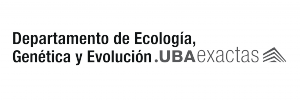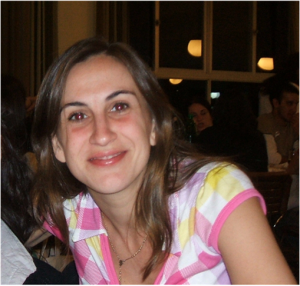Grupo de Investigación en Filogenias y Filogeografía (GIFF)
El GIFF tiene como eje central de sus líneas de investigación el uso de datos genómicos para poner a prueba distintas hipótesis genético poblacionales y evolutivas, tanto a nivel infraespecífico, como supraespecífico.
INVESTIGADORA RESPONSABLE
Viviana Andrea Confalonieri. Doctora de la Universidad de Buenos Aires (UBA, Argentina), área Ciencias Biológicas. Es Investigadora Principal del Consejo Nacional de Investigaciones Científicas y Tecnológicas (CONICET), Argentina, en el Instituto IEGEBA (UBA-CONICET). Profesora Titular en el Departamento de Ecología, Genética y Evolución (EGE) de la Facultad de Ciencias Exactas y Naturales (FCEN), UBA. Dicta «Genética y Ecología Molecular»
https://orcid.org/0000-0003-4499-9816
https://sites.google.com/site/ecologiaygenetica
Confalonieri se ha especializado en las áreas “Genética Evolutiva” y dentro de ésta, en los últimos años se ha dedicado a la “Genética Ecológica”, es decir a responder preguntas ecológicas con herramientas teóricas y metodológicas que nacen de la teoría evolutiva, la genética de poblaciones, y de la biología molecular. Ha publicado mas de 90 artículos sobre estas temáticas. En la actualidad sus investigaciones se centran en estudios filogeográficos y filogenéticos de insectos plagas de cultivos, especialmente gorgojos, langostas y hormigas. Los estudios llevados a cabo por ella y su grupo de investigación han indicado que algunos gorgojos nativos de Sud América han invadido con éxito ambientes marginales en todo el mundo debido a la reproducción asexual, que a su vez se asocia posiblemente con la presencia del endosimbionteWolbachia. Por otro lado, estudios realizados en una langosta (Trimerotropispallidipennis) les permitieron demostrar el rol que cumplirían algunas reestructuraciones cromosómicas en la adaptación a distintos ambientes y como disparadores de procesos especiogénicos. Asimismo, se destacan sus investigaciones biogeográficas basadas en filogenias moleculares, que les permitieron analizar la evolución de distintos grupos en relación a la ocurrencia de eventos geológicos y climáticos, como el surgimiento de las islas Galápagos y del Istmo de Panamá, la deriva continental que llevó a la separación de África y América, el levantamiento de la Cordillera de los Andes y/o las últimas glaciaciones que ocurrieron durante el Pleistoceno. Su producción científica también incluye estudios genético-poblacionales y citogenéticos en razas de Zea mays nativas de América del Sur, y de otras especies emparentadas al maíz. Los resultados de estos estudios ayudaron a dilucidar las rutas de dispersión del maíz domesticado desde América Central hasta Sud América.
Otros integrantes del grupo GIFF
Dra Marcela Rodriguero
Investigadora Independiente CONICET
Ayudante de Primera en el curso «Genética y Ecología Molecular» del Departamento EGE
La Dra. Marcela Rodriguero realiza estudios genético-evolutivos en gorgojos partenogenéticos de la tribu Naupactini, conocidos comúnmente como “gorgojos de la alfalfa”, abarcando aspectos tales como el origen de este modo reproductivo y sus consecuencias en el genoma, en la demografía y en la capacidad colonizadora de dichos insectos, con especial énfasis en el estudio de la interacción con el parásito reproductivo Wolbachiapipientis. Más recientemente, ha ampliado el alcance de estos estudios abarcando otros endosimbiotes bacterianos y realizando análisis de ecología microbiana.
Con respecto al origen de la partenogénesis en gorgojos de la tribu Naupactini, ha estudiado principalmente la infección con el parásito reproductivo Wolbachiapipientis y la poliploidía como posibles desencadenantes de este fenómeno.
En cuanto a las consecuencias de la partenogénesis en este grupo de insectos, se han estudiado las huellas genómicas de la pérdida de la sexualidad, el sexo ocasional como un medio de contrarrestar los riesgos a largo plazo de la falta de sexo, la especiación incipiente mediada por Wolbachia y el impacto de este modo reproductivo en la capacidad colonizadora de gorgojos invasores que expandieron su área de distribución.
Actualmente, está estudiando la importancia de la densidad bacteriana en la interacción reproductiva entre Wolbachia y los gorgojos naupactínidos, el impacto de la microbiota residente en la invasión y consecuente colonización de esta bacteria en dichos hospedadores y la identificación de funciones bacterianas a través de estudios de genómica comparativa.
Dra Francisca Cunha Almeida
Investigadora Independiente CONICET
Jefe de Trabajos Prácticos de la materia “Genómica Evolutiva y Poblacional” del departamento EGE.
La Dra. Francisca CunhaAlmeida lidera la línea de investigación sobre “Patrones y procesos evolutivos en vertebrados terrestres”, dentro del cual se ubican tres subproyectos:
“Filogeografía y filogenia de murciélagos del género Histiotus”,
“Evolución y biogeografía de aves tinamiformes” “Filogenía y macroevolución de murciélagos pteropódidos”.
Además, colabora en diversos proyectos sobre evolución molecular y genómica evolutiva comparada en diferentes taxones.
Dra Noelia Verónica Guzmán
Investigador Adjunto CONICET. Lidera la línea de investigación sobre “Estudios filogenomicos, filogeográficos y biogeográficos en AcrididaeNeotropicales de distribución Andina”.
Dra Daniela Monti
Investigadora Asistente CONICET
La DraMonti estudia los «Patrones Evolutivos y Biogeográficos de la Familia Olenidae (Arthropoda, Trilobita) durante el Cámbrico tardío – Ordovícico”
La línea de investigación se enfoca en el estudio de la diversificación y evolución de los olénidos, una familia de trilobites que habitó los mares del Cámbrico tardío y Ordovícico, afectados por intensos cambios en los ecosistemas.
Mediante la aplicación de métodos filogenéticos, morfogeométricos y biogeográficos se evalúan los patrones de distribución paleogeográfica del grupo y la variación inter e intraespecífica de sus miembros en un contexto evolutivo.
Dr Diego Alfredo Caraballo
Investigador Asistente CONICET.
https://sites.google.com/view/diegocaraballo/
El Dr. Diego Caraballo estudia los genes, genomas, organismos y ambiente a través de estudios filogenéticos, genómico-poblacionales y espaciales en organismos de interés agronómico y zoonótico. Hace uso de herramientas del campo de la filogenia, la filogeografía, la genómica y el análisis de datos espaciales, para responder a problemas relacionados con el origen y mantenimiento de la diversidad, así como la adaptación de los organismos al ambiente.
Sus líneas de investigación son:
- Especiación y adaptación a diferentes altitudes en tucuras de distribución andina: .Estudios genómico-poblacionales en un grupo de tucuras de distribución andina para poner a prueba la influencia de factores orogénicos y climáticos como disparadores de procesos especiogénicos y de adaptación a diferentes altitudes.
- Saltos de hospedador, recombinación y adaptación en virus zoonóticos, con dos sublíneas: a) Saltos de hospedador y evolución del virus de la rabia en carnívoros sudamericanos y b) Diversidad y saltos de hospedador de coronavirus en mamíferos.
- Patrones de diversificación genética en murciélagos de Argentina: Análisis de la diversidad de murciélagos del género Molossus en Argentina. Revisión de la sistemática y cotejo entre filogenias multi-locus y análisis morfológicos.
- Evolución y diversificación en roedores del género Ctenomys. Con tres sublíneas: a)Delimitación de especies en el grupo Corrientes de Ctenomys; b) Análisis filogeográfico y genético-poblacional de Ctenomyspearsoni; y c) Evolución del principal ADN satélite de Ctenomys.
Lic. Pablo Dinghi
Docente Full Time en el departamento de Biodiversidad y Biología Experimental
Tema de investigación: “Estudios biogeográficos en Melanoplinae Sudamericanos: patrones de diversificación a lo largo de la cordillera de los Andes”
Lic. Lucia Fernandez Goya
Becaria Doctoral de la Universidad de Buenos Aires.
Lucía Fernández Goya Se encuentra realizando sus estudios doctorales bajo la dirección de las Dras. Marcela S. Rodriguero y Viviana A. Confalonieri.
Su tema de tesis se enfoca en el rol que ejerce la bacteria Wolbachiapipientisen la reproducción de linajes partenogenéticos de Pantomoruspostfasciatus, un gorgojo de la tribu Naupactini (Coleroptera, Curculionidae).
Adicionalmente, aborda la colocalización de Wolbachiacon otros endosimbiontes en distintos tejidos de otras especies de Naupactini y la posibilidad de que organismos parasitoides de estas especies hayan facilitado la transmisión horizontal de Wolbachia
Lic. Ingrith Mejía Fontecha
Estudiante doctoral. Becada por la Agencia Nacional de Promoción Científica y Tecnológica.
Tema de tesis: “Filogeografía y filogenia de Histiotus (Chiroptera, Vespertilionidae) con énfasis en las especies argentinas«
Directoras: Francisca Almeida y AnalíaGimenez
PUBLICACIONES del GRUPO(2018 – 2023)
Basualdo, J.P., Zelaya, V.M., Fernandez, P.V., Leliaert, F., Rodríguez, M.C., Confalonieri, V., Ciancia, M. Twodifferentmorphotypes of freshwaterCladophora surera (Cladophorales, Chlorophyta) produce similar sulfatedcellwallpolysaccharides (2023) AlgalResearch, 70, art. no. 102956.. DOI: 10.1016/j.algal.2022.102956
Moreyra, N.N., Almeida, F.C., Allan, C., Frankel, N., Matzkin, L.M., Hasson, E. Phylogenomicsprovidesinsightsintotheevolution of cactophily and host plantshifts in Drosophila (2023) Molecular Phylogenetics and Evolution, 178, art. no. 107653, . DOI: 10.1016/j.ympev.2022.107653
Pavé, R., Schierloh, P., Chambi, M. et al. Morphological and molecular analysesconfirmthepresence of thenewlydescribedbatspeciesMolossusmelini in the Espinal ecoregionfrom Argentina. Mamm Res (2023). https://doi.org/10.1007/s13364-023-00679-1
Caraballo DA, López SL, Botero-Cañola S, Gardner SL, Fillingthe gap in distributionranges and conservation status in Ctenomys (Rodentia: Ctenomyidae) (2023) Journal of Mammalogy, gyac099, https://doi.org/10.1093/jmammal/gyac099
Rodriguero, M.S. Parthenogenesis (2022) ReproductiveStrategies in Insects, pp. 35-71. DOI: 10.1201/9781003043195-3 Book Chapter
Monti, D.S., Tortello, M.F., Confalonieri, V.A. A phylogeneticapproachtothestudy of theevolution of Hypermecaspididae (Olenida, Trilobita) (2022) Papers in Palaeontology, 8 (3), art. no. e1433. DOI: 10.1002/spp2.1433
Fernandez Goya, L., Lanteri, A.A., Confalonieri, V.A., Rodriguero, M.S. New host-parasitoidinteractions in Naupactuscervinus (Coleoptera, Curculionidae) raisethequestion of Wolbachia horizontal transmission (2022) Symbiosis, 86 (3), pp. 325-336. DOI: 10.1007/s13199-022-00838-z
Guzmán, N.V., Kemppainen, P., Monti, D., Castillo, E.R.D., Rodriguero, M.S., Sánchez-Restrepo, A.F., Cigliano, M.M., Confalonieri, V.A. Stableinversionclines in a grasshopperspeciesgroupdespitecomplexgeographicalhistory (2022) Molecular Ecology, 31 (4), pp. 1196-1215. DOI: 10.1111/mec.16305
Maffey, L., Confalonieri, V., Hasson, E., Schweigmann, N. City puzzles: Doesurbanlandscapeaffectgeneticpopulationstructure in Aedes aegypti? (2022) PLoSNeglected Tropical Diseases, 16 (7), art. no. e0010549. DOI: 10.1371/JOURNAL.PNTD.0010549
Pérez, D.E., Monti, D.S. Phylogeneticaffinities of thepoorlyknownbivalvegenusXenocarditaVokes, 1946 (Bivalvia: Carditidae): new data ontheevolution of thetripartite radial ribs (2022) CretaceousResearch, 137, art. no. 105260, . DOI: 10.1016/j.cretres.2022.105260
Caraballo, D.A., Sabio, M.S., Colombo, V.C., Piccirilli, M.G., Vico, L., Hirmas Riade, S.M., Campos, J., Martínez, G., Beltrán, F., Baumeister, E., Cisterna, D.M. The Role of Molossidae and Vespertilionidae in ShapingtheDiversity of Alphacoronaviruses in theAmericas (2022) MicrobiologySpectrum, 10 (6), . DOI: 10.1128/spectrum.03143-22
Caraballo, D.A. Cross-SpeciesTransmission of BatCoronaviruses in theAmericas: ContrastingPatternsbetweenAlphacoronavirus and Betacoronavirus (2022) MicrobiologySpectrum, 10 (4), . DOI: 10.1128/spectrum.01411-22
Buschiazzo, L.M., Caraballo, D.A., Labaroni, C.A., Teta, P., Rossi, M.S., Bidau, C.J., Lanzone, C. Comprehensivecytogeneticanalysis of themostchromosomally variable mammaliangenusfrom South America: Ctenomys (Rodentia: Caviomorpha: Ctenomyidae) (2022) MammalianBiology, . DOI: 10.1007/s42991-022-00312-9
Caraballo, D.A., Lema, C., Novaro, L., Gury-Dohmen, F., Russo, S., Beltrán, F.J., Palacios, G., Cisterna, D.M. A novel terrestrial rabies virus lineageoccurring in southamerica: Origin, diversification, and evidence of contactbetween wild and domesticcycles (2021) Viruses, 13 (12), art. no. 2484, . DOI: 10.3390/v13122484
Nayyab, S., Gervasi, M.G., Tourzani, D.A., Caraballo, D.A., Jha, K.N., Teves, M.E., Cui, W., Georg, G.I., Visconti, P.E., Salicioni, A.M. TSSK3, a novel target formalecontraception, isrequiredforspermiogenesis (2021) Molecular Reproduction and Development, 88 (11), pp. 718-730. Cited 5 times. DOI: 10.1002/mrd.23539
Mackay-Smith, A., Dornon, M.K., Lucier, R., Okimoto, A., de Sousa, F.M., Rodriguero, M., Confalonieri, V., Lanteri, A.A., Sequeira, A.S. Host-specific gene expression as a toolforintroductionsuccess in Naupactusparthenogeneticweevils (2021) PLoS ONE, 16 (7 July), art. no. e0248202. DOI: 10.1371/journal.pone.0248202
Rodriguero, M.S., Scannapieco, A.C., Monti, D.S., Chifflet, L., Elias-Costa, A.J., Lanteri, A.A., Confalonieri, V.A. Dependence of egghatchingonWolbachiadensity in a parthenogeneticweevilrevealedbyantibiotictreatment (2021) EntomologiaExperimentalis et Applicata, 169 (4), pp. 384-392. DOI: 10.1111/eea.13019
Fernández Campón, F., NisakaSolferini, V., Carrara, R., Marvaldi, A.E., Confalonieri, V. Phenotypicplasticity and thecolonization of new habitats: a study of a colonial spider in the Chaco region and the Cerrado (2021) EvolutionaryEcology, 35 (2), pp. 235-251. DOI: 10.1007/s10682-021-10105-0
Velazco, P.M., Almeida, F.C., Cláudio, V.C., Giménez, A.L., Giannini, N.P. A New Species of HistiotusGervais, 1856 (Chiroptera, Vespertilionidae), fromthePacificCoast of NorthernPeru (2021) American MuseumNovitates, 2021 (3979), pp. 1-30. DOI: 10.1206/3979.1
Almeida, F.C., Amador, L.I., Giannini, N.P. Explosiveradiation at theorigin of Old Worldfruitbats (Chiroptera, Pteropodidae) (2021) OrganismsDiversity and Evolution, 21 (1), pp. 231-243. DOI: 10.1007/s13127-021-00480-5
Caraballo, D.A., Lombardo, M.A., Becker, P., Sabio, M.S., Lema, C., Martínez, L.M., Beltrán, F.J., Li, Y., Cisterna, D.M. Evaluation of two real-time, taqman reverse transcription-pcrassaysfordetection of rabies virus in circulatingvariantsfrom argentina: Influence of sequencevariation (2021) Viruses, 13 (1), art. no. 23, . DOI: 10.3390/v13010023
Maffey, L., Garzón, M.J., Confalonieri, V., Chanampa, M.M., Hasson, E., Schweigmann, N. Genome-widescreening of aedesaegypti (Culicidae: Diptera) populationsfromnorthwestern argentina: Active and passivedispersalshapegeneticstructure (2020) Journal of Medical Entomology, 57 (6), pp. 1930-1941. DOI: 10.1093/jme/tjaa125
Fernandez Goya, L., Imberti, M., Rodriguero, M.S., Fanara, J.J., Risso, G., Lavagnino, N.J. Mitochondrialgeneticdiversity of theinvasivedrosophilidZaprionusindianus (Diptera: Drosophilidae) in South America (2020) BiologicalInvasions, 22 (12), pp. 3481-3486.
Scattolini, M.C., Lira-Noriega, A., Confalonieri, V.A., Pietrokovsky, S., Cigliano, M.M. Biogeographicalpatterns and processes in thegenusgroupScotussae (Acrididae: Melanoplinae): anintegrativeapproach (2020) BiologicalJournal of theLinneanSociety, 131 (2), pp. 417-433. DOI: 10.1093/biolinnean/blaa100
Sánchez-Restrepo, A.F., Chifflet, L., Confalonieri, V.A., Tsutsui, N.D., Pesquero, M.A., Calcaterra, L.A. A speciesdelimitationapproachtouncovercrypticspecies in the South American fireantdecapitatingflies (Diptera: Phoridae: Pseudacteon) (2020) PLoS ONE, 15 (7 July), art. no. e0236086. DOI: 10.1371/journal.pone.0236086
Pérez-Barros, P., Guzmán, N.V., Confalonieri, V.A., Lovrich, G.A. Molecular identificationbypolymerasechainreaction-restrictionfragmentlengthpolymorphism of commerciallyimportantlithodidspecies (Crustacea: Anomura) fromsouthern South America: Molecular identification of lithodidsfromsouthern South America (2020) Regional Studies in Marine Science, 34, art. no. 101027, DOI: 10.1016/j.rsma.2019.101027
Amador, L.I., Almeida, F.C., Giannini, N.P. Evolution of TraditionalAerodynamic Variables in Bats (Mammalia: Chiroptera) within a ComprehensivePhylogenetic Framework (2020) Journal of MammalianEvolution, 27 (3), pp. 549-561. DOI: 10.1007/s10914-019-09475-8
Almeida, F.C., Simmons, N.B., Giannini, N.P. A Species-LevelPhylogeny of Old WorldFruitBatswith a New Higher-LevelClassification of theFamilyPteropodidae (2020) American MuseumNovitates, 2020-April (3950), pp. 1-24. DOI: 10.1206/3950.1
Moyers Arévalo, R.L., Amador, L.I., Almeida, F.C., Giannini, N.P. Evolution of BodyMass in Bats: Insightsfrom a LargeSupermatrixPhylogeny (2020) Journal of MammalianEvolution, 27 (1), pp. 123-138. DOI: 10.1007/s10914-018-9447-8
Dinghi, P.A., Guzmán, N.V., Monti, D.S. PlayingwithDragons: A ludicexperience as anintroductiontophylogeneticconcepts in biodiversityteaching [Jugando con Dragones: Una experiencia lúdica como introducción a los conceptos filogenéticos en la enseñanza de la biodiversidad] (2020) Revista Eureka, 17 (1), art. no. 1201, . DOI: 10.25267/Rev_Eureka_ensen_divulg_cienc.2020.v17.i1.1201
Genise, J.F., Bellosi, E.S., Sarzetti, L.C., Krause, J.M., Dinghi, P.A., Sánchez, M.V., Umazano, A.M., Puerta, P., Cantil, L.F., Jicha, B.R. 100 Masweatbeenests: Early and rapidcodiversification of crownbees and floweringplants (2020) PLoS ONE, 15 (1), art. no. e0227789, . DOI: 10.1371/journal.pone.0227789
Caraballo DA, Montani ME, Martínez LM, Antoniazzi LR, Sambrana TC, Fernández C, et al. (2020) Heterogeneoustaxonomicresolution of cytochrome b gene identification of batsfrom Argentina: Implicationsforfieldstudies. (2020) PLoS ONE 15(12): e0244750. https://doi.org/10.1371/journal.pone.0244750
Rodriguero, M.S., Guzmán, N.V., Lanteri, A.A., Confalonieri, V.A. TheEffect of ReproductiveSystemonInvasiveness: Lessonsfrom South American Weevils (2019) Florida Entomologist, 102 (3), pp. 495-500. DOI: 10.1653/024.102.0309
Del Rió, M.G., Guzmán, N.V., Montemayor, S.I., Confalonieri, V.A., Lanteri, A.A.PotentialGeographicDistributions of TwoParthenogeneticWeevils (Coleoptera: Curculionidae) Associatedwith Citrus in Argentina and Brazil (2019) Florida Entomologist, 102 (3), pp. 459-463. DOI: 10.1653/024.102.0328
Sánchez-Restrepo, A.F., Jiménez, N.L., Confalonieri, V.A., Calcaterra, L.A. Distribution and diversity of leaf-cuttingants in Northeastern Argentina: speciesmostassociatedwithforestplantations (2019) International Journal of Pest Management, 65 (3), pp. 244-257. DOI: 10.1080/09670874.2018.1555343
Monti, D.S., Confalonieri, V.A. Firstcladisticanalysis of thetrilobitefamilyOlenidaefromtheFurongian and Ordovician (2019) Lethaia, 52 (3), pp. 304-322. DOI: 10.1111/let.12313
Elias-Costa, A.J., Confalonieri, V.A., Lanteri, A.A., Rodriguero, M.S. Game of clones: IsWolbachiainducingspeciation in a weevilwith a mixedreproductivemode? (2019) Molecular Phylogenetics and Evolution, 133, pp. 42-53. DOI: 10.1016/j.ympev.2018.12.027
Moreyra, N.N., Mensch, J., Hurtado, J., Almeida, F., Laprida, C., Hasson, E. Whatdoesmitogenomicstellusabouttheevolutionaryhistory of the Drosophila buzzatiicluster (repleta group)? (2019) PLoS ONE, 14 (11), art. no. e0220676, . DOI: 10.1371/journal.pone.0220676
Giménez, A.L., Giannini, N.P., Almeida, F.C. Mitochondrialgeneticdifferentiation and phylogeneticrelationships of threeeptesicus (Histiotus) species in a contactzone in patagonia [Diferenciación genética mitocondrial y relaciones filogenéticas entre tres especies de Eptesicus (Histiotus) en una zona de contacto en la Patagonia] (2019) MastozoologiaNeotropical, 26 (2), pp. 349-358. Cited 8 times. DOI: 10.31687/saremMN.19.26.2.0.10
Hurtado, J., Almeida, F., Revale, S., Hasson, E. Revisedphylogeneticrelationshipswithinthe Drosophila buzzatiispeciescluster (Diptera: Drosophilidae: Drosophila repleta group) usinggenomic data (2019) ArthropodSystematics and Phylogeny, 77 (2), pp. 239-250. DOI: 10.26049/ASP77-2-2019-03
Villafañe, I.E.G., Guzmán, N., Ortiz, N., González-Ittig, R.E., León, V.A., Busch, M. ConnectivityamongNorwayratsubpopulations (Rattusnorvegicus) at poultryfarms in exaltaciÓn de la cruz, buenos aires, Argentina [Conectividad entre las subpoblaciones de rata noruega (Rattusnorvegicus) que habitan granjas avícolas de exaltación de la cruz, buenos aires, Argentina] (2019) MastozoologiaNeotropical, 26 (2), pp. 359-367. DOI: 10.31687/saremMN.19.26.2.0.16
Sarzetti, L.C., Genise, J.F., Dinghi, P., Alejandra Molina, M. Anoverview of hymenopterancocoons as a tooltointerpretichnospecies of Fictovichnus (Pallichnidae) and otherfossilcocoons of wasps (2019) Palaios, 34 (11), pp. 562-574. DOI: 10.2110/palo.2019.053
Chifflet, L., Guzmán, N.V., Rey, O., Confalonieri, V.A., Calcaterra, L.A. Southernexpansion of theinvasiveantWasmanniaauropunctatawithinitsnativerange and itsrelationwithclonality and human activity (2018) PLoS ONE, 13 (11), art. no. e0206602. DOI: 10.1371/journal.pone.0206602
del Río, M.G., Rodriguero, M.S., Confalonieri, V.A., Lanteri, A.A. Molecular and morphologicalphylogeneticanalysis of NaupactusDejean (Curculionidae: Entiminae) and Allied Genera: Thedilemma of classification (2018) Diversity, 10 (3), art. no. 59. DOI: 10.3390/d10030059
Rodriguero, M.S., Wirth, S.A., Alberghina, J.S., Lanteri, A.A., Confalonieri, V.A. A tale of swingerinsects: Signatures of pastsexualitybetweendivergentlineages of a parthenogeneticweevilrevealedbyribosomalintraindividualvariation (2018) PLoS ONE, 13 (5), art. no. e0195551, DOI: 10.1371/journal.pone.0195551
Pocco, M.E., Guzmán, N., Plischuk, S., Confalonieri, V., Lange, C.E., Cigliano, M.M. Diversificationpatterns of thegrasshoppergenusZoniopodaStål (Romaleidae, Acridoidea, Orthoptera) in open vegetationbiomes of South America (2018) SystematicEntomology, 43 (2), pp. 290-307. DOI: 10.1111/syen.12277
Scattolini, M.C., Confalonieri, V., Lira-Noriega, A., Pietrokovsky, S., Cigliano, M.M. Diversificationmechanisms in theAndeangrasshoppergenusOrotettix (Orthoptera: Acrididae): Ecological niches and evolutionaryhistory (2018) BiologicalJournal of theLinneanSociety, 123 (4), pp. 697-711.
Chuchuy, A., Rodriguero, M.S., Ferrari, W., Ciota, A.T., Kramer, L.D., Micieli, M.V. Biologicalcharacterization of Aedes albopictus (Diptera: Culicidae) in Argentina: Implicationsforarbovirustransmission. (2018) ScientificReports, 8 (1), art. no. 5041, . DOI: 10.1038/s41598-018-23401-7
Berruezo, L.A., Mercado Cárdenas, G.E., Harries, E.M., Stenglein, S.A., Curti, R.N., Rodriguero, M.S., Galván, M.Z. Characterization of Fusarium speciesassociatedwithtobaccodiseases in Northwestern Argentina (2018) EuropeanJournal of PlantPathology, 151 (4), pp. 1065-1079.
Amador, L.I., Moyers Arévalo, R.L., Almeida, F.C., Catalano, S.A., Giannini, N.P. BatSystematics in the Light of UnconstrainedAnalyses of a Comprehensive Molecular Supermatrix (2018) Journal of MammalianEvolution, 25 (1), pp. 37-70. DOI: 10.1007/s10914-016-9363-8
Monti, D.S. Morphometrics of Leptoplastidesmarianus (Hoek) (Trilobita, Olenidae) fromtheTremadocian of north-western Argentina: taxonomicimplications (2018) Journal of SystematicPalaeontology, 16 (3), pp. 179-197. DOI: 10.1080/14772019.2017.1282992
Tortello, M.F., Zeballo, F.J., Monti, D.S. A late Furongiantrilobiteassemblagefromtheeastern Cordillera Oriental (Santa Rosita Formation; Jujuy, Argentina) and itsbiostratigraphicsignificance [Una asociación de trilobites del Furongiano tardío del sector este de la Cordillera Oriental (Formación Santa Rosita; Jujuy, Argentina) y su significado bioestratigráfico] (2018) Revista del Museo Argentino de Ciencias Naturales, Nueva Serie, 20 (2), pp. 271-282. DOI: 10.22179/REVMACN.20.601












